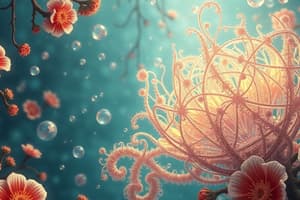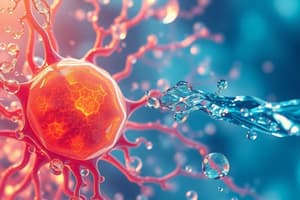Podcast
Questions and Answers
What did Robert Hooke observe in 1665 under the microscope?
What did Robert Hooke observe in 1665 under the microscope?
- Blood corpuscles
- Mitochondria
- Bacteria
- Cells in cork (correct)
Which of the following statements is NOT part of the cell theory formulated by Schleiden and Schwann?
Which of the following statements is NOT part of the cell theory formulated by Schleiden and Schwann?
- Cells have well-defined organelles. (correct)
- Cells arise from pre-existing cells.
- All organisms are composed of cells.
- Cells are the basic unit of life.
Which component is found in all eukaryotic cells?
Which component is found in all eukaryotic cells?
- Cytoplasm
- Cell membrane
- Nuclear membrane (correct)
- Naked DNA
What term describes organisms that do not possess a well-defined nucleus?
What term describes organisms that do not possess a well-defined nucleus?
In which part of the cell is the nucleus located?
In which part of the cell is the nucleus located?
What is the primary difference between archaebacteria and eubacteria?
What is the primary difference between archaebacteria and eubacteria?
Which of the following organelles is NOT typically found in prokaryotic cells?
Which of the following organelles is NOT typically found in prokaryotic cells?
What term is used to describe the life-giving substance that includes the cytoplasm and nucleus in a cell?
What term is used to describe the life-giving substance that includes the cytoplasm and nucleus in a cell?
What characteristic is true about Archaebacteria?
What characteristic is true about Archaebacteria?
Which of the following is a well-studied eubacterium?
Which of the following is a well-studied eubacterium?
What is the main function of the cell membrane?
What is the main function of the cell membrane?
What is a distinguishing feature of the cell wall?
What is a distinguishing feature of the cell wall?
What does the Endoplasmic Reticulum (ER) provide to the cytoplasmic matrix?
What does the Endoplasmic Reticulum (ER) provide to the cytoplasmic matrix?
Which organelle is responsible for packaging materials within the cell?
Which organelle is responsible for packaging materials within the cell?
What best describes the Ribosomes?
What best describes the Ribosomes?
Which feature of the Golgi Complex is responsible for its shape?
Which feature of the Golgi Complex is responsible for its shape?
What is the primary function of flagella?
What is the primary function of flagella?
What do plastids in plant cells primarily contribute to?
What do plastids in plant cells primarily contribute to?
What role do vacuoles primarily serve in plant cells?
What role do vacuoles primarily serve in plant cells?
Which of the following best describes peroxisomes?
Which of the following best describes peroxisomes?
How do vesicles assist in cellular function?
How do vesicles assist in cellular function?
What type of molecules do vacuoles store?
What type of molecules do vacuoles store?
Which type of organelle is characterized by being a membrane-bound compartment filled with fluid?
Which type of organelle is characterized by being a membrane-bound compartment filled with fluid?
What distinguishes cilia from flagella?
What distinguishes cilia from flagella?
What occurs to the carboxylate ion when the pH becomes acidic?
What occurs to the carboxylate ion when the pH becomes acidic?
How does hemoglobin assist in buffering during exercise?
How does hemoglobin assist in buffering during exercise?
What happens to amino groups in proteins when blood pH is alkaline?
What happens to amino groups in proteins when blood pH is alkaline?
What is the role of the globin portion of hemoglobin in buffering?
What is the role of the globin portion of hemoglobin in buffering?
How does alkaline condition affect dihydrogen phosphate ions in the cell?
How does alkaline condition affect dihydrogen phosphate ions in the cell?
Which property of a buffer system ensures it does not pass through cell membranes?
Which property of a buffer system ensures it does not pass through cell membranes?
Why should citrate and phosphate buffers be avoided in calcium dependent reactions?
Why should citrate and phosphate buffers be avoided in calcium dependent reactions?
What is the ideal physiological ionic strength range for buffer systems?
What is the ideal physiological ionic strength range for buffer systems?
What type of absorbance should a buffer system have to avoid interference in spectrophotometric assays?
What type of absorbance should a buffer system have to avoid interference in spectrophotometric assays?
What is a key feature of the bicarbonate buffer system related to blood pH?
What is a key feature of the bicarbonate buffer system related to blood pH?
What characteristic should buffers possess regarding their chemical interactions in biological systems?
What characteristic should buffers possess regarding their chemical interactions in biological systems?
What is a primary component of the phosphate buffer system in cells?
What is a primary component of the phosphate buffer system in cells?
What feature of buffers contributes to their practical use in laboratory settings?
What feature of buffers contributes to their practical use in laboratory settings?
Study Notes
Cell Landmarks
- Anton Van Leeuwenhoek invented the microscope; Robert Hooke observed cork cells in 1665, coining the term "cell" from Latin meaning "small room."
- Leeuwenhoek identified bacteria, sperm, and red blood cells in 1672.
- In 1831, Robert Brown discovered the nucleus in all cells.
Cell Theory
- Formulated in 1838 by M.J. Schleiden and Theodore Schwann.
- Asserts that all organisms are made of cells, cells are the structural and functional units of life, and new cells arise from existing ones.
Definition of a Cell
- A cell is a unit of protoplasm, enclosed by a plasma membrane, containing a nucleus.
- Protoplasm comprises cytoplasm and the nucleus; cytoplasm contains organelles like ribosomes, mitochondria, Golgi bodies, plastids, lysosomes, and endoplasmic reticulum.
- Plant cells have large vacuoles; bacteria lack defined organelles and a well-formed nucleus.
Types of Cells
- Two main categories: prokaryotic and eukaryotic.
- Prokaryotes lack a well-formed nucleus (e.g., bacteria); eukaryotes have a defined nucleus.
Prokaryotic Cells
- Simple, single-celled organisms; have basic organelles.
- Divided into two groups:
- Archaebacteria: thrive in extreme environments.
- Eubacteria: true bacteria, commonly found in diverse habitats (e.g., Escherichia coli).
Organelles Overview
- Structures that enable cell function, growth, and reproduction.
Cell Membrane
- Semi-permeable outer layer of the cell made of proteins, carbohydrates, and a phospholipid bilayer (Fluid Mosaic Model).
- Facilitates selective passage and transport of molecules.
Cell Wall
- Found in plants and fungi; thicker than the cell membrane, consisting of three layers.
- Provides shape, facilitates cell interaction, and protects from harmful substances.
Endoplasmic Reticulum (ER)
- A system of tubular structures; two types: rough (with ribosomes) and smooth.
- Directly connected to the nucleus, provides mechanical support.
Golgi Complex/Apparatus
- Composed of flat, disc-shaped structures (cisternae) near the nucleus.
- Responsible for packaging materials, modifying proteins, and forming glycolipids and glycoproteins.
Ribosomes
- Composed of ribonucleic acid and proteins; essential for protein synthesis.
- Flagella provide movement; cilia assist with cell movement.
Plastids
- Double-membrane organelles in plants, containing pigments (chloroplasts, chromoplasts, leukoplasts).
- Involved in photosynthesis and synthesis of organic compounds.
Peroxisomes
- Membrane-bound organelles that oxidize biomolecules, producing hydrogen peroxide.
- Contain catalase to convert hydrogen peroxide into water and oxygen.
Vacuoles
- Membrane-bound, fluid-filled spaces that store water, enzymes, and waste products.
- Take up 80-90% of plant cells, involved in detoxifying and waste export.
Vesicles
- Spherical compartments formed from the Golgi apparatus, ER, or cell membrane.
- Function in storage, transport, and isolation of materials, including waste and nutrients.
Characteristics of Water
- Major chemical component of Earth's surface; essential for biological systems.
- High solubility and membrane permeability important for buffer efficacy.
- Excessive ions can disrupt biological processes; ideal buffer should minimize ion buildup.
Buffer Preparation Considerations
- Should remain inert, stable, and should not absorb light in spectrophotometric ranges.
- Should allow selective ion concentration without forming complexes, easy to prepare, and inexpensive.
Buffer Systems in Biological Systems
- Bicarbonate Buffer: Maintains blood pH; converts excess acids into carbon dioxide and bicarbonate ions for excretion.
- Phosphate Buffer: Operates in cell fluids; manages pH by reacting with excess hydrogen or hydroxide ions.
- Protein Buffer: Utilizes amino acids' carboxylic acid and amino groups to balance pH changes.
- Hemoglobin Buffer: Regulates tissue pH by binding protons or oxygen, crucial during physical exertion.
Studying That Suits You
Use AI to generate personalized quizzes and flashcards to suit your learning preferences.
Related Documents
Description
This quiz focuses on the key concepts related to cells, water, and buffers in biochemistry. It explores historical discoveries in the study of cells, including observations made by pioneers like Anton Van Leeuwenhoek and Robert Hooke. Test your knowledge on the significance of cells and their components.




